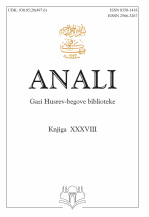ČETIRISTOGODIŠNJICA VAKUFA ISMAIL-AGE, DIZDARA TVRĐAVE BOČAC 1617. - 2017.
FOUR HUNDRED YEARS OF SMAIL-AGA’S VAKF, DIZDAR OF BOČAC FORTRESS
Author(s): Haso PoparaSubject(s): Modern Age, Recent History (1900 till today), Theology and Religion, Islam studies
Published by: Gazi Husrev-begova biblioteka
Keywords: Ismail-aga; dizdar; Bočac; Agići; endowment chart; mosque; maktab; tekke; Smailagić;
Summary/Abstract: Although the vakf of Smail-aga, dizdar (fortress commander) of Bočac Fortress of 1026/1617 once was on of the biggest agrarian vakfs in Bosnia and Herzegovina, no separate paper has ever been written on it. Based on the relevant sources and original documents, some of which are presented to the public for the first time, we are herewith revealing a few of completely new information on Ismail-aga’s ancestors, relatives and descendants among whom are the names of three new dizdars, spanning over four centuries that had seen the succession of six governments: Ottoman Empire, Austro-Hungarian Empire, Kingdom of Yugoslavia, Independent State of Croatia, Socialist Yugoslavia, and independent Bosnia and Herzegovina. This paper chronologically follows the destiny of the vakf from its founding to the present day. Looking into the transcription of the List of Lots belonging to Ismail-aga’s vakf No, 506 made on August 11, 1928, as compiled by the Islamic Community of Banja Luka, and into the land register excerpt No. 160 for the Cadaster Municipality Agino Selo issued by Municipal department for geodetic registers and cadaster of Banja Luka of February 24, 1987, it can with certainty be said that this vakf was located on the right side of the river Vrbas, downstream to Džemat place in the village of Bočac on the south to Krmin in the north, and from river Vrbas to the slopes of Čemernica, Tisovac, and Osmača mountains. Its surface encompassed over 10,000 dunums, arable land, meadows, orchards, forests, boskets, and pastures. The income of the Ismail-aga’s vakf was intended for maintenance of mosque, makatab, and tekke that he had built in his native village of Trifkovina before 1671. This place was named after him- Agici. In the area of this vakf, some twenty villages were created. They all belong to the present-day Agino Selo and Bočac. The remains of this vakf, mainly forests and some arable land, approximately 8,000 dunums, belonged to the Smailagić families all until the war of 1992-1996. They all now live abroad.
Journal: Anali Gazi Husrev-begove biblioteke
- Issue Year: 2017
- Issue No: 38
- Page Range: 77-104
- Page Count: 28
- Language: Bosnian

